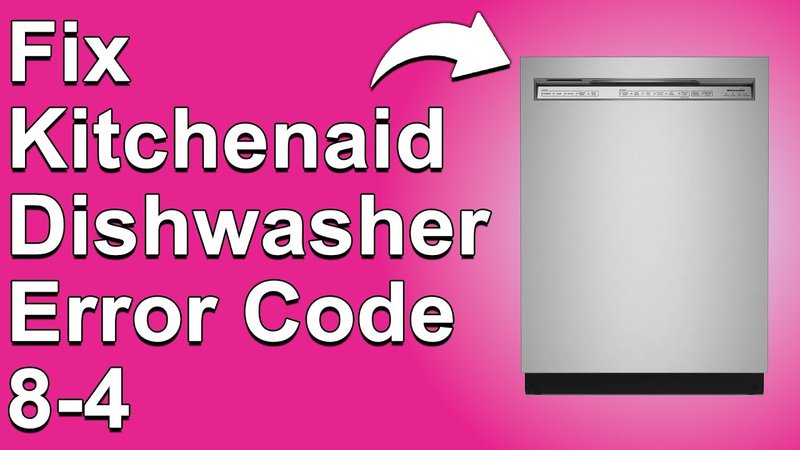
So, why should you care about fixing it promptly? Well, ignoring the error isn’t just about dealing with a few dirty plates. Over time, small issues like this can lead to bigger problems, ultimately reducing your appliance’s lifespan. Here’s the thing: appliances are like cars. You wouldn’t ignore the check engine light on your car, right? Just as a car needs proper maintenance to avoid breakdowns, your dishwasher needs attention to function efficiently and last longer.
Understanding the “HE” Error Code
Before anything else, you need to know what “HE” stands for and why it appears in the first place. The code itself is pretty straightforward: it indicates a Heating Error. When your Kitchenaid dishwasher flashes “HE,” it’s telling you there’s a problem with the element that heats water in the machine. This element is crucial because hot water boosts the detergent’s effectiveness, ensuring your dishes come out sparkling clean.
So, what’s happening inside? Think of the heating element like the hot water system in your house. Just as you need hot water to take a shower or wash your clothes, your dishwasher needs it to wash your dishes. If the element fails, it’s like trying to shower with cold water. Not ideal, right? Without the heat, dishes remain greasy, and germs can linger, which is not what you want for items you eat off.
Now, you might wonder why this error occurs. There could be several underlying reasons: a faulty heating element, issues with the thermostat that regulates temperature, or even problems with the wiring delivering electricity to these components. Each of these parts needs to work in harmony to heat the water just right. If one part fails, the whole system is disrupted, resulting in that dreaded “HE” code.
Consequences of Ignoring the Error
Let’s talk about what happens if you hold off on getting it fixed. The immediate effect might seem minor—just a few unclean dishes. However, in the long run, ignoring this error can lead to more serious and costly problems. First off, your dishwasher’s performance will noticeably drop. With cold water, it can’t effectively break down food particles or sanitize your dishes, causing repeated cycles and increased water usage.
Think of it this way: trying to wash oily pots with cold water is like using a blunt knife to slice a tomato. Sure, you can do it, but it’s messy and inefficient. Over time, the strain on the other components in your dishwasher could lead to more frequent malfunctions or even a complete breakdown. This means you might end up spending more on repairs or even needing a replacement sooner than expected, which isn’t great for your budget.
Moreover, an unresolved heating issue can result in damage to other components. The undue stress on the motor and the pump can lead to more wear and tear, as they work harder to achieve what should be a routine wash. And let’s not forget about hygiene—using a dishwasher that can’t sanitize means you risk potential health hazards from bacteria and germs. To put it bluntly, it’s not just your peace of mind that’s at stake, but your family’s health too.
How to Address the Issue
So, you’ve decided you’re not going to ignore the issue. Great! But what’s next? Fixing the “HE” error doesn’t always require a professional, though calling one can guarantee a swift resolution. First, you’ll want to perform a basic check yourself. Unplug your dishwasher and inspect the heating element for visible signs of damage. Any discoloration or broken parts indicate it’s time for a replacement. Think of it like checking your car’s oil—easy but essential.
If everything looks good, the next step is to test the thermostat. This can be a bit more technical but can be done with a multimeter, a handy tool for checking electrical readings. If you’re unsure, don’t hesitate to consult the user manual or reach out to Kitchenaid customer service. They can provide step-by-step guidance tailored to your specific model. Alternatively, a quick search online can yield plenty of video tutorials and forums where fellow users share their experiences.
In some cases, the fix might involve replacing damaged wiring or components, which should be left to a professional to avoid electrical risks. By addressing the problem head-on, you not only solve the immediate issue but also extend the life of your dishwasher, ensuring it serves you well for many more meals to come.
Prevention Tips to Avoid Future Issues
Once you’ve resolved the “HE” error, it’s wise to take some preventative measures to keep it from cropping up again. Regular maintenance is the key here. Just as you wouldn’t skip a car service, a little attention goes a long way with your dishwasher. Start by ensuring you’re not overloading the machine. Cramming in too many dishes can obstruct water flow, affecting the heating element’s function.
Another tip is to use the recommended detergent and maintain the right water hardness. Hard water can lead to build-ups that compromise the heating element, similar to how lime scale affects your kettle. Investing in a good water softener could be a smart move if you have hard water in your area. Also, periodically inspect the filter and clean it to ensure smooth operation.
Lastly, make it a habit to run a vinegar cycle every so often. Just set a wash with a couple of cups of vinegar and no dishes. This simple trick helps clear any soap residue and keeps your machine smelling fresh. With these small steps, you can ensure that your trusty dishwasher continues to work efficiently, error-free, for years to come.